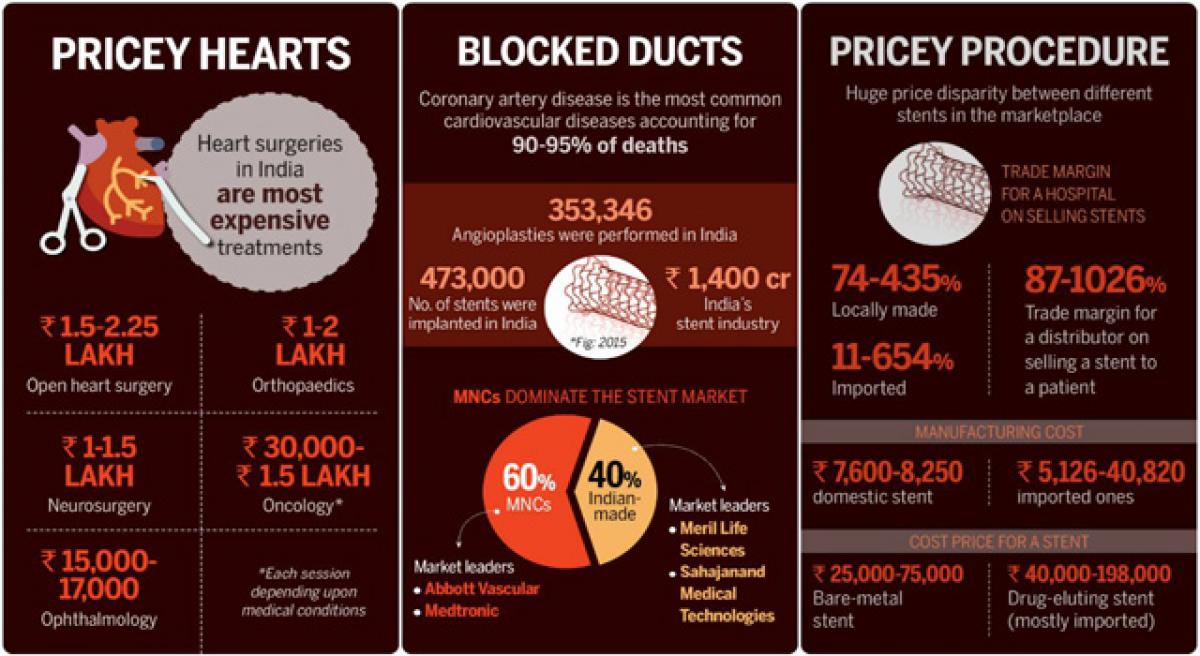Live
- Pitroda's inheritance tax remarks fuel fresh attack
- Dharmavaram: A mastermind that played a spoilsport for TDP rivals
- KCR launches poll bus yatra
- Revanth dares KCR, Harish
- Modi frustrated, afraid of invisible voters: Kharge
- SC seeks clarification from EC on functioning of EVMs
- Vijayawada: ‘People disgusted with YSRCP govt, seek change’
- EC pores over Cong’s plaint against Modi’s speech
- MyVoice: Views of our readers 25th April 2024
- Visakhapatnam: NDA government will make AP corruption-free says Rajnath Singh
Just In

The announcement of policy to cap the price of coronary stents by the central government is truly historic and path-breaking in the health care sector. Coronary Artery Diseases (CAD) causing heart attacks leading to untimely deaths have steeply increased in the country.
The announcement of policy to cap the price of coronary stents by the central government is truly historic and path-breaking in the health care sector. Coronary Artery Diseases (CAD) causing heart attacks leading to untimely deaths have steeply increased in the country. CAD is no more the disease of rich, even poor are getting affected by this. Apart from other risk factors, people without any history of excessive smoking or drinking bear the brunt of heart attack, due to fast-paced lifestyle, which can lead to various diseases.
India has several big hospitals across the country equipped with world-class facilities and eminent cardiologists. In recent years, the number of angioplasty with stents has tripled as it is safe, effective and non-surgical procedure (no scar on the chest, no anesthesia) and just one-day hospital stay has made it more popular option. However, the prohibitively expensive stents made it difficult for the poor and lower middle class people to go for this.
When the cost of Coronary Artery Bypass Grafting (CABG) was anywhere between Rs 80,000 and 1,20,000, the more attractive Angioplasty with stent was Rs 1,50,000 to Rs 4-5 lakh, making it inaccessible for ordinary man. When the expertise to use multiple stents increased, the greed of earning more also increased, as a result more patients started getting 3-4 stents, adding to the cost. On an average, over 12,000 angioplasties are carried out in Mumbai Metropolitan Region annually.
In some hospitals, Angioplasty packages cost a bomb. There’s a huge price disparity in cost of stents. The average landed cost of an imported DES was only Rs 16,918 (ranged between Rs. 12,920 and 19,040. The cost of BMS ranged between Rs 4,760 to 6,120. But various hospitals are giving package deals –Angioplasty (With one stent) from Rs 2,20,000 to 3,60,000.
The question arises if the original cost is so low, then why are the hospitals charging so exorbitantly?
The reason is evident. The Maharashtra FDA found that a prominent multinational healthcare company was selling DES at Rs 40,710 instead of Rs 19,040 in India, making a net profit of Rs 21,670 on each stent. Further the Indian distributor was selling at Rs 73,440 (making net profit of Rs 32,730) while a well-known private Hospital was implanting the stent for Rs 1.1 lakh. In the bill, it was reflected as Rs 1.2 to 1.5 lakhs per stent.
This translates to a cool profit of Rs 76,560 per patient! International companies looked the other way when their distributors were selling the stents at triple the cost on which the DES was being imported. More stents were sold as Indian distributors, who hiked prices for DES, used part of the proceeds to encourage doctors to recommend more and more stents.
Thus the stunt of overpricing stents continued until the Government of India took it up sternly and decided to cap the prices to ensure that common man can also afford the treatment without getting into debt situation. The government led by Prime Minister Modi certainly deserves commendation for the efforts it made in this direction.
The Union Health Ministry issued a notification announcing that coronary stents would be added to the 2015 National List of Essential Medicines (NLEM). The National Pharmaceutical Pricing Authority (NPPA), under Department of Pharmaceuticals (DoP), during a study conducted on pricing of stents in the country, observed that the bulk of medical devices including stents consumed in the country is imported and the difference between the landed cost and the Maximum Retail Price (MRP) thereof is very high.
NPPA had capped prices of bare metal stents at Rs 7,260 and that of drug-eluting and bio-resorbable stents at Rs 29,600, on February 13. The arguments put forth by government on price cap are based on the recommendations of Subcommittee appointed by the judiciary. The current Indian market is around 5.50 lakh stents annually, out of which more than 90 per cent are DES. The stent market is growing at around 15% annually and is expected to become the second largest market in the World after China by 2020.
The bold step to cap prices of stents will be a boon to suffering patients and their families. It is strongly believed that this shall break the existing nexus and result in hospitals becoming transparent with the prices of stents. (The writer is Professor of Pediatric Cardiology at the Bengaluru Medical College and Research Institute)
By Dr I B Vijayalakshmi

© 2024 Hyderabad Media House Limited/The Hans India. All rights reserved. Powered by hocalwire.com







